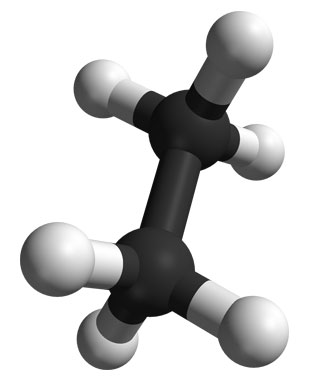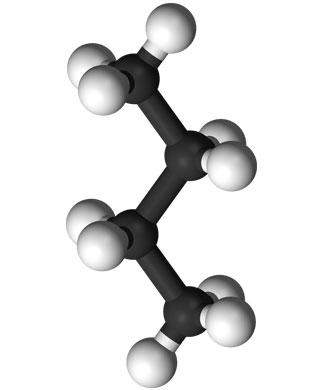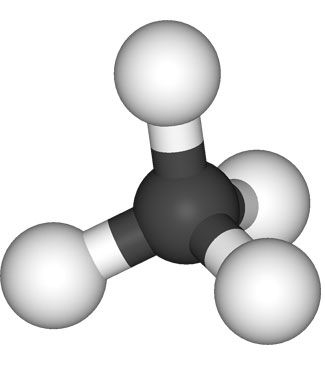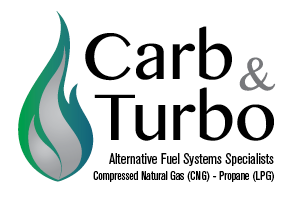CNG, LNG, and LPG have one thing in common...
They all come from natural gas.

Basically, the refinement process removes:
Ethane (1st)

Propane (2nd)

Butane (3rd)

Natural Gas (4th)

Propane is available in two distinct types, liquid and vapor, and is one of the main ingredients in natural gas before it is fractionated (propane is also refined from oil). Most propane is extracted from natural gas during the second of four refinement phases. After it is extracted, propane undergoes specific processes for use as liquid propane or as gaseous/vaporized propane.
Natural gas is fractionated at the tail end of the production process.
Compressed natural gas (CNG) is natural gas that has been compressed to a pressure of 3,600 PSI and kept in a gaseous form, instead of being converted into a liquid.
FEATURES & BENEFITS
Natural gas and propane require a higher temperature to ignite than diesel or gasoline. Among alternative fuels, propane has the most narrow flammability range. It’s been in use since 1912, and today is the third most commonly-used fuel. Equipment and tanks are subject to rigorous safety standards and crash testing. Propane tanks are 20x more puncture-resistant than gasoline tanks. Neither propane nor natural gas deteriorate, thus no additives are necessary to keep them fresh. CNG (compressed natural gas), LNG (liquefied natural gas), and LPG (liquefied propane gas) cannot be ingested like alcohol, diesel, or gasoline fuels.

Natural Gas and Propane are plentiful with vast reserves; in fact, the U. S. is a net exporter of propane… meaning that we export more than we consume. There’s an established and growing refueling infrastructure consisting of thousands of registered public dispensers… at the time this information was gathered, there were 876 CNG, 74 LNG and 1,536 LPG stations. More stations are frequently being added to the existing network. To learn more, for a current station listing, and to download an app for your mobile phone, click here.

Natural gas and propane substantially reduce greenhouse gases and other harmful emissions such as Carbon Dioxide, Carbon Monoxide, Nitrous Oxide and particulate matter. Both are hydrocarbons; natural gas (CH4) contains only one (1) carbon molecule; propane (C3H8) contains three (3) carbon molecules. Comparatively, gasoline contains eight (8) carbon molecules.
Natural gas and propane are approved clean fuels listed in the 1990 Clean Air Act and the Energy Policy Act of 1992. They are two of the cleanest burning of all fossil fuels. Both are non-toxic and free of lead, benzene and sulfur, so they won’t harm air, soil or water. Tests conducted by the U. S. Environmental Protection Agency (EPA) prove that natural gas or propane-fueled vehicles produce approximately 60% fewer carbon monoxide emissions and about 50% fewer toxins and other smog-producing emissions (compared to gasoline engines). Natural gas and propane-powered equipment allows users to safely operate in enclosed environments without the use of a breathing apparatus and comply with Ozone Action Days.
An Ozone Action Day, which can be declared by a Local Municipality, County or State government, is observed at certain times during summer months (typically), when weather conditions run the risk of causing health concerns (e.g. air stagnation, heat, humidity, smog, etc).
Ozone Action Days (a.k.a. Clean Air Alerts) primarily occur in Midwestern portions of the U.S.; particularly in well-urbanized areas such as Chicago, Cleveland, Detroit and Indianapolis. An Ozone Action Day may be announced with as few as one day advance notice – leaving commercial enterprises such as golf courses and landscapers precious little time for planning. Government entities monitor weather conditions and the Air Quality Index (AQI). The AQI is divided into six levels: the higher the number (on a scale of 0 – 300), the more severe the ozone threat air quality index.
Heavy industries make up a relatively high percentage of pollutants causing ‘ground ozone’. Without drastically altering or eliminating industrial production in an area altogether, air quality improvements are very slight, though noticeable. Non-industrial pollutants, while not thought of to be a major pollutant group, can be more easily influenced with more positive change occurring.
Basic steps in limiting ground ozone during Ozone Action Days are:
- Controlling auto emissions and ensure that automotive exhaust systems properly function
- Eliminate excessive engine idling
- Whenever possible, avoid unnecessary driving
- Limit refueling between the hours of 6:00 PM and 8:00 AM
- Use public transportation (some cities may provide free bus service during Ozone Action Days)
- Limit the use of lawn mowers and outdoor grills to after 6:00 PM
- Limit the use of aerosol cans
Natural gas and propane have a higher octane rating – as much as 105 – 120 vs. 87 – 94 (for gasoline). It helps prevent detonation; stops pinging or knocking noises; and, extends spark plug life (no fouling). Multi-fuel systems allow drivers to seamlessly switch between natural gas or propane and gasoline during all driving conditions and significantly extend driving range. On small engine equipment with dual tanks, such as lawn mowers, propane provides longer operating times between refueling, using approximately one gallon per hour (each tank contains about 7.5 gallons, total of 15 gallons).

Typically, natural gas and propane are about $0.50 – $1.50 (per gallon) less than gasoline; the difference is usually even greater when compared to diesel. Prices are projected to remain less expensive than gasoline or diesel; especially during summer months when the demand for natural gas and propane shrinks while the demand for other fossil fuels spike. Plus, for applications where the equipment is not operated on a road, you’ll save the road tax. Lastly, there may be Government (Federal & State) and/or Industry (PERC & MPA) incentives that’ll expedite your return on investment (ROI).
Natural gas and propane utilize a closed fuel system. As a result, engine components run cleaner with less wear & tear and require less maintenance. Some customers have reported extended service intervals and that they are able to operate equipment/vehicles two (2) to three (3) years longer. Natural gas and propane contain no ethanol which eliminates or significantly reduces gummed up carburetor components. They also run cooler and will not vapor-lock.
Tank exchange and/or private/public dispensers allow you to safely, conveniently, quickly and easily refuel with no spillage, evaporation, pilferage or water in the fuel tank.
Alternative fuels such as natural gas and propane provide businesses with the opportunity to market/promote their company as an environmentally-friendly entity; all other considerations being equal, it may be the difference maker in winning a bid or contract.
